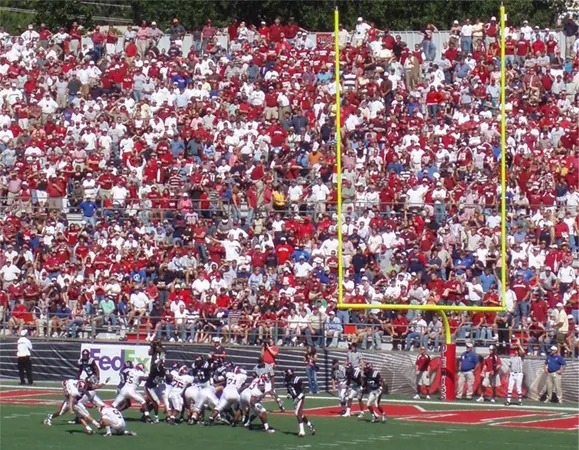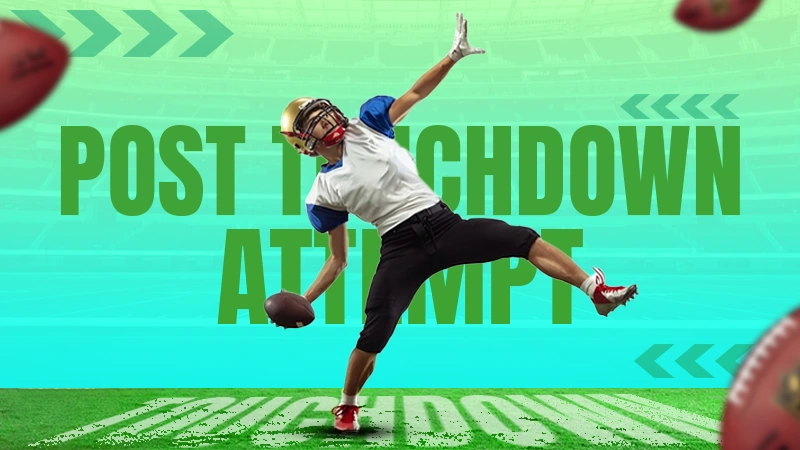In American football, a touchdown is one of the most exciting and important moments in the game. However, the excitement doesn’t just end there. Right after the touchdown, teams have the opportunity to score additional points via post touchdown attempts.
With players vying for any points in the game, these attempts can significantly impact the outcome of the game. Post touchdown attempts become a key point for everyone involved in the game. Post-touchdown attempts consist of either a one-point try – known as an extra point or point after touchdown – or a two-point attempt.
In this article, we will delve into the mechanics, historical evolution, strategic considerations, and the significance of post-touchdown attempts in American football.
Historical Evolution of Post-Touchdown Attempts

The time right after a touchdown is pivotal moment in the game and has evolved significantly since the inception of American football. After a touchdown, teams have the opportunity to score an additional one point or two points.
To understand it completely, we must look at its historical context. Initially, the extra point was the only option for the team to score. It was almost an automatic and straightforward kick from a short distance. As the game developed further, the need for more strategic depth and variability in scoring arose, and then we saw the amendment.
The two-point conversion rule was introduced later in the game in the NFL after a successful trial in college football. This new rule added more complexity to the game as they had to choose between a guaranteed one-point or an attempt for a more challenging two-point play.
As we’ve mentioned, there are two types of post touchdown attempts. Here is how the mechanics of post touchdown attempts work.
- One Point Kick – After a touchdown, the team can kick the ball, from the 15-yard line, between the goal posts behind the opponent’s endzones. With the successful kick, teams can earn one extra point. This is commonly referred to as the point after touchdown (PAT).
- Two-Point Conversion – This is a more complex play. Instead of going for the safe kick option, the teams can get the ball across the goal line into the endzone one more time after a touchdown. This will award the team two extra points. This can be achieved using a run or a pass, making it a risky option.
Strategic Considerations
Attempting an extra point or a two-point conversion is influenced by various strategic considerations. Teams must consider the game’s score, time remaining, team strengths, and specific situation factors.
Score and Time
One of the most important considerations is the game’s score and time remaining in the game. For a team trailing, a two-point conversion might be a more appealing option out of the two. However, in a tight game where every point counts, coaches and players might prefer the extra point without taking a risk or a two-point attempt.
Team Strengths and Weaknesses
The strengths and weaknesses play a significant role in deciding which approach to take. Teams that have strong offensive lines and effective short-yardage running backs may favor two-point conversions. Similarly, teams that have a reliable kicker may go for the extra points.
Situational Factors
Other situational factors including weather conditions, injuries, and the defensive capabilities of the opposition can also impact the decision-making process. Wind or rain might make kicking more challenging, motivating the team to go for a two-point conversion. Injuries to key players can also impact the decision.
Statistical Analysis of Post Touchdown Attempt NYT
Success Rates
Statistically, one-point kicks have a higher success rate. The success rate for extra points hovers around 94-95%. Whereas the success rate of two-point conversion might be about 48-50%, but it offers higher rewards. These figures tell us that there is a risk associated with attempting a two-point conversion.
The success rates of both are crucial metrics for teams to consider. Understanding this helps the team make an informed decision on which one to go for.
Game Impact
Successful post touchdown attempts can have a significant impact on the game. If a team is successful in the two-point conversion, the momentum of the match can swing in their favor. Failing in a two-point attempt can boost the opposition and shift the game in their favor.
Decision Analytics
Coaches nowadays use more Advanced analytics and statistical models when making decisions relating to post touchdown attempts. These statistical models use historical data, situational context, and probabilistic outcomes as well. For example, a model might suggest a higher likelihood of success for a two-point conversion based on specific defensive alignments or tendencies of the opposing team.
Popularity of Two-Point Conversions
We’ve seen the popularity of two-point conversions increase in recent years. This trend suggests a shift towards a more aggressive approach to the game. As we’ve established, coaches use more Advanced analytics and statistical models to inform their decisions. These models have shown that two-point conversion can be advantageous in certain situations.
Famous Post-Touchdown Attempts
Let’s take a look at the most famous post-touchdown attempts.
The Philly Special
One of the most famous two-point conversion attempts in recent NFL history is the “Philly Special” accomplished by the Philadelphia Eagles during Super Bowl LII. During this trick play, a direct snap to the running back was given, a handoff to a tight end, and then a pass to the quarterback. And that was it. This play showed us the nature of the creativity and high-risk reward of the two-point attempts.
Denver Broncos’ 2015 Season
The Denver Broncos frequently opted for two-point conversions when the team was led by head coach Gary Kubiak. The team utilized their strong defensive capabilities and versatile offensive plays. In that season, the strategic use of two-point attempts allowed them to reach Super Bowl victory.
Read Next: NFL May Allow 12 Players on the Field for This One Specific Reason
Conclusion
In American football, a post touchdown attempt is a crucial aspect of the game. It adds a layer of strategy, excitement, and complexity. The decision to even go for an extra point or two-point conversion depends on a lot of factors including game situation, team strengths, and time remaining.
Understanding the history, impact, and strategy of these attempts enhances our appreciation of this crucial element of the game. With time, the strategies and innovations of post-touchdown attempts will continue to evolve.
For everyone involved in the game, the post touchdown attempt remains a critical moment in the game. It is merely an opportunity to score an extra point. It is a decision that reflects the team’s understanding of the game. And teams can gain an advantage by mastering this aspect of the game.





